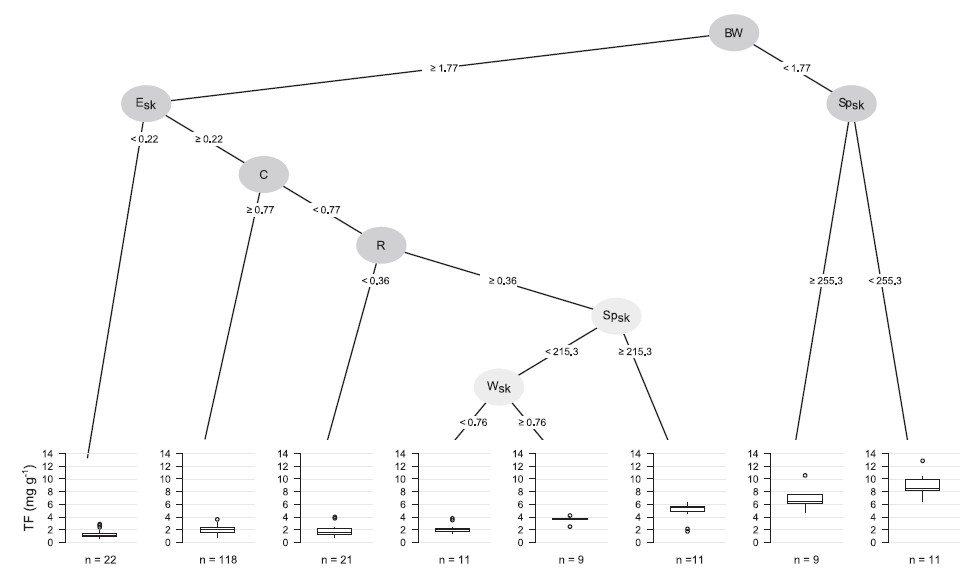Journal article published in Computers and Electronics in Agriculture, volume 117, pp. 186–193.
Authors: .
Abstract
Flavonoids are a class of bioactive compounds largely represented in grapevine and wine. They also affect the sensory quality of fruits and vegetables, and derived products. Methods available for flavonoid measurement are time-consuming, thus a rapid and cost-effective determination of these compounds is an important research objective. This work tests if applying machine learning techniques to texture analysis data allows to reach good performances for flavonoid estimation in grape berries. Whole berry and skin texture analysis was applied to berries from 22 red wine grape cultivars and linked to the total flavonoid content. Three machine-learning techniques (regression tree, random forest and gradient boosting machine) were then applied. Models reached a high accuracy both in the external and internal validation. The R2 ranged from 0.75 to 0.85 for the external validation and from 0.65 to 0.75 for the internal validation, while RMSE (Root Mean Square Error) went from 0.95 mg/g to 0.7 mg/g in the external validation and from 1.3 mg/g to 1.1 mg/g in the internal validation.
Key words flavonoids; gradient Boosting Machine (GBM); random forest; texture analysis; wine grapes
BibTeX entry: click to show
@article{
2318_1526764,
url = {https://hdl.handle.net/2318/1526764},
author = {Brillante, Luca and Gaiotti, Federica and Lovat, Lorenzo and Vincenzi, Simone and Giacosa, Simone and Torchio, Fabrizio and Río Segade, Susana and Rolle, Luca and Tomasi, Diego},
title = {Investigating the use of gradient boosting machine, random forest and their ensemble to predict skin flavonoid content from berry physical-mechanical characteristics in wine grapes},
year = {2015},
journal = {Computers and Electronics in Agriculture},
volume = {117},
abstract = {Flavonoids are a class of bioactive compounds largely represented in grapevine and wine. They also affect the sensory quality of fruits and vegetables, and derived products. Methods available for flavonoid measurement are time-consuming, thus a rapid and cost-effective determination of these compounds is an important research objective. This work tests if applying machine learning techniques to texture analysis data allows to reach good performances for flavonoid estimation in grape berries. Whole berry and skin texture analysis was applied to berries from 22 red wine grape cultivars and linked to the total flavonoid content. Three machine-learning techniques (regression tree, random forest and gradient boosting machine) were then applied. Models reached a high accuracy both in the external and internal validation. The R2 ranged from 0.75 to 0.85 for the external validation and from 0.65 to 0.75 for the internal validation, while RMSE (Root Mean Square Error) went from 0.95 mg/g to 0.7 mg/g in the external validation and from 1.3 mg/g to 1.1 mg/g in the internal validation.},
keywords = {flavonoids; gradient Boosting Machine (GBM); random forest; texture analysis; wine grapes},
doi = {10.1016/j.compag.2015.07.017},
pages = {186--193}
}
Publication availability
Accepted manuscript
This file is available in an accepted manuscript version from the IRIS institutional repository.
This file is subjected to usage limitations according to its license.
View or request this publication
You can find the postprint version of this article in the Open Access Repository of the University of Torino:
IRIS-AperTO record 2318/1526764
View the final version at publisher:
doi:10.1016/j.compag.2015.07.017
File not available? Do you need further information?
You can contact me and request this article through the following form:
